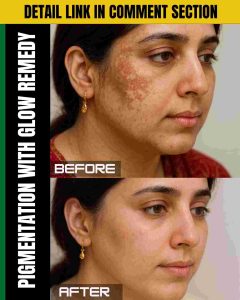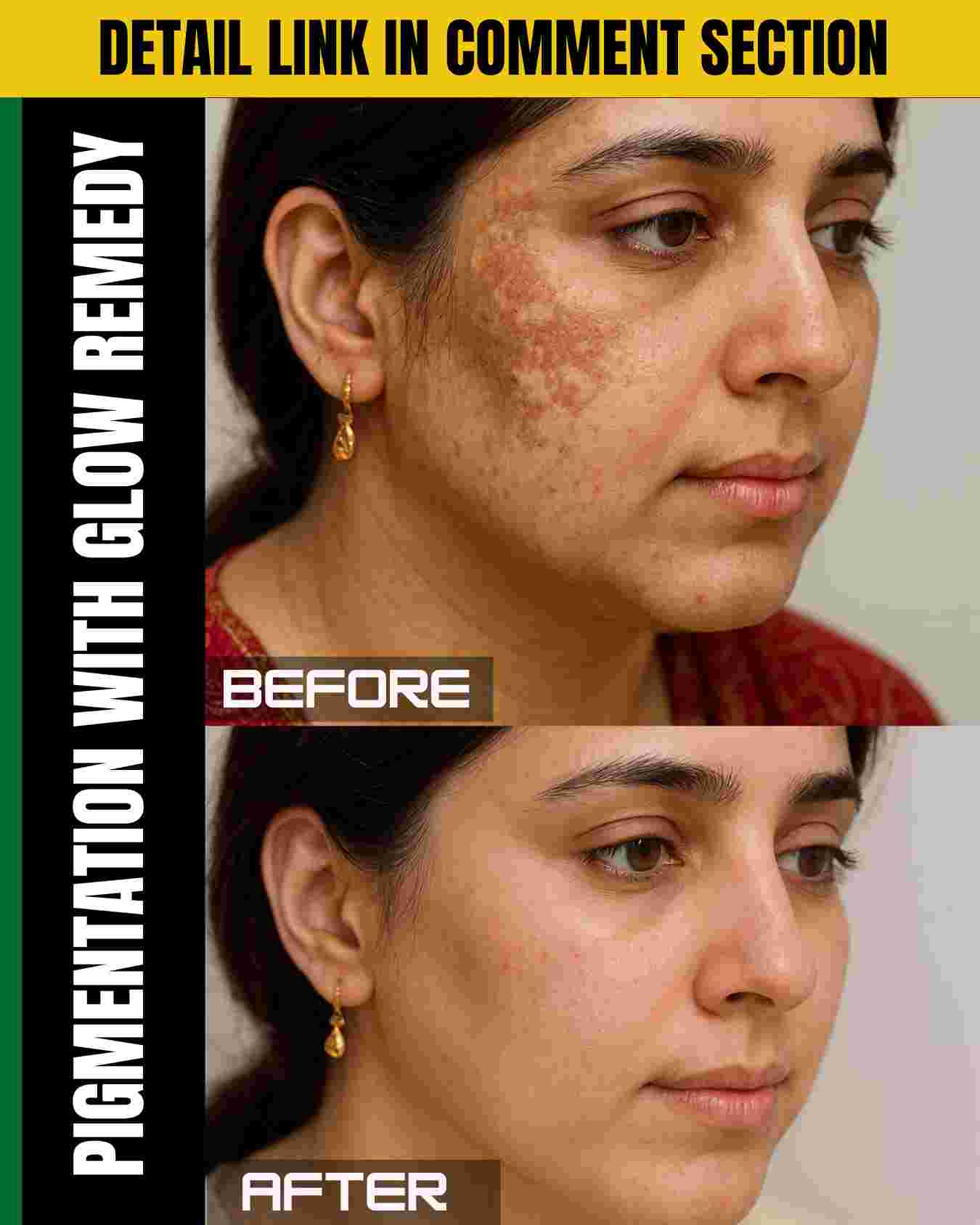Pigmentation can make the skin look uneven, tired, and dull. Dark patches often affect confidence because they stand out on the face more than any other issue. Many people try quick fixes but end up damaging their skin barrier. The safest and most effective approach is to use natural ingredients backed by scientific benefits. When these ingredients are applied according to skin type, results appear faster and the natural glow becomes visible within a few days.
Below are simple yet powerful remedies designed for five different skin types. Each remedy uses only natural ingredients, easy to find in any home kitchen. Every ingredient includes a short scientific explanation so you know exactly how it works.

Remedy 1: For Normal Skin
Scientific Working of Ingredients
Normal skin accepts balanced treatments. This remedy targets excess melanin production while restoring smooth glow.
Ingredients:
- Aloe vera gel – 2 tbsp
– Contains aloesin which slows excess melanin activity. - Rice flour – 1 tbsp
– Rich in phytic acid that brightens pigmentation. - Raw honey – 1 tsp
– Acts as a humectant, keeping skin hydrated and glowing. - Tomato juice – 1 tbsp
– Lycopene reduces dark spots caused by sun damage. - Yogurt – 1 tbsp
– Lactic acid gently exfoliates pigmented layers.
Procedure:
Mix all ingredients until smooth. Clean your face. Apply a thick layer on the pigmented areas and rest for 15 minutes. Rinse with cool water.
How Often:
Use daily for 3–5 days.
Initial Results (Day 1–3):
Mild brightening, softer texture, early reduction in dullness, slight fading on light pigmentation spots.
Remedy 2: For Combination Skin
Scientific Working of Ingredients
Combination skin needs oil-balancing plus pigment reduction.
Ingredients:
- Multani mitti – 1 tbsp
– Absorbs excess oil and clears clogged pores where pigment collects. - Aloe vera – 1 tbsp
– Controls melanin and soothes both dry and oily zones. - Potato juice – 1 tbsp
– Contains catecholase enzyme which reduces dark patches. - Rose water – 1 tbsp
– Balances pH and prevents irritation. - Turmeric – 1 pinch
– Curcumin reduces inflammation and melanin buildup.
Procedure:
Blend everything to make a paste. Apply evenly on the full face. Keep until semi-dry. Wash with lukewarm water.
How Often:
Use alternate days for the first week.
Initial Results (Day 1–3):
Oily areas appear balanced, small spots start lightening, skin tone appears more even and fresh.
Remedy 3: For Oily Skin
Scientific Working of Ingredients
Oily skin holds pigmentation more deeply due to trapped sebum. This remedy targets oil control and reduces dark spots.
Ingredients:
- Lemon juice – ½ tsp
– Citric acid removes pigmented layers (use in low quantity). - Green tea – 2 tbsp cooled
– EGCG reduces dark patches and controls oil oxidation. - Neem powder – 1 tsp
– Anti-bacterial and reduces post-acne pigmentation. - Rice water – 1 tbsp
– Fermented nutrients brighten skin. - Besan – 1 tbsp
– Deep cleans oil and exfoliates gently.
Procedure:
Make a smooth paste with all ingredients. Apply on pigmented zones, especially around the mouth and cheeks. Keep for 12 minutes, then wash.
How Often:
Use every day for 3 days.
Initial Results (Day 1–3):
Oil becomes controlled, pores look tighter, early fading on acne marks, and a dull area gets a mild glow.
Remedy 4: For Dry Skin
Scientific Working of Ingredients
Dry skin holds pigmentation due to dead cell buildup. Hydration plus brightening ingredients give fast glow.
Ingredients:
- Milk cream – 1 tbsp
– Contains lactic acid + fats for deep hydration and exfoliation. - Saffron threads – 3 soaked in 1 tsp milk
– Crocin pigment gives natural brightening. - Honey – 1 tsp
– Locks moisture and adds natural shine. - Almond powder – 1 tbsp
– Vitamin E repairs pigmented skin. - Banana mash – 1 tbsp
– Contains potassium which softens and revives dull skin.
Procedure:
Mix all into a thick creamy mask. Apply evenly and massage gently for 1 minute. Leave for 15 minutes and rinse.
How Often:
Use daily for 4 consecutive days.
Initial Results (Day 1–3):
Dry patches feel soft, glow becomes visible, and pigmented areas appear lighter.
Remedy 5: For Sensitive Skin
Scientific Working of Ingredients
Sensitive skin needs calming ingredients that reduce inflammation without triggering irritation.
Ingredients:
- Cucumber juice – 2 tbsp
– Silica hydrates and reduces redness around pigmentation. - Aloe vera – 1 tbsp
– Aloesin reduces melanin gently. - Oat flour – 1 tbsp
– Beta-glucan repairs the skin barrier. - Chamomile tea – 2 tbsp
– Contains apigenin which calms inflammation causing darkening. - Honey – 1 tsp
– Heals micro-damaged areas.
Procedure:
Combine into a soothing gel-like paste. Apply a thin layer and leave for 10–12 minutes. Wash with cool water.
How Often:
Use daily for 3–5 days.
Initial Results (Day 1–3):
Redness reduces, pigmentation softens, and a gentle, healthy glow appears.
Weekly Diet Plan for Fading Pigmentation & Natural Glow
This diet works for vegetarian, non-vegetarian, diabetic, and cholesterol-care individuals with small adjustments.
Morning (Daily)
– 1 glass lukewarm water + lemon (diabetics skip lemon)
– 5 soaked almonds
– 1 fruit: apple, guava, or papaya
Breakfast
Vegetarian: Oats with chia seeds + yogurt
Non-veg: 1 boiled egg + whole wheat toast
Diabetic: Unsweetened oats + nuts
Cholesterol-care: Egg whites only + apple
Lunch
– 1 bowl mixed vegetables
– 1 roti or ½ cup boiled rice
– 1 bowl lentils
– Add cucumber or beetroot slices
Evening Snack
– Green tea or chamomile tea
– 1 small handful of nuts
Dinner
Vegetarian: Grilled vegetables + brown rice
Non-veg: Grilled chicken/fish + salad
Diabetic: Grilled vegetables + lentil soup
Cholesterol-care: Fish (once a week) + vegetables
Before Bed
– Warm milk with a pinch of turmeric (diabetics avoid honey)
This diet reduces oxidative stress, balances hormones, and supports natural brightening from within.
Final Tips
Stay hydrated.
Sleep at least 7 hours.
Wash hands before touching your face.
Keep skincare tools clean.
Always do a patch test before any remedy.
Avoid harsh scrubs and chemical-loaded products.
Results usually begin within 2–3 days, and with continued use, pigmentation fades and glow becomes stable.
